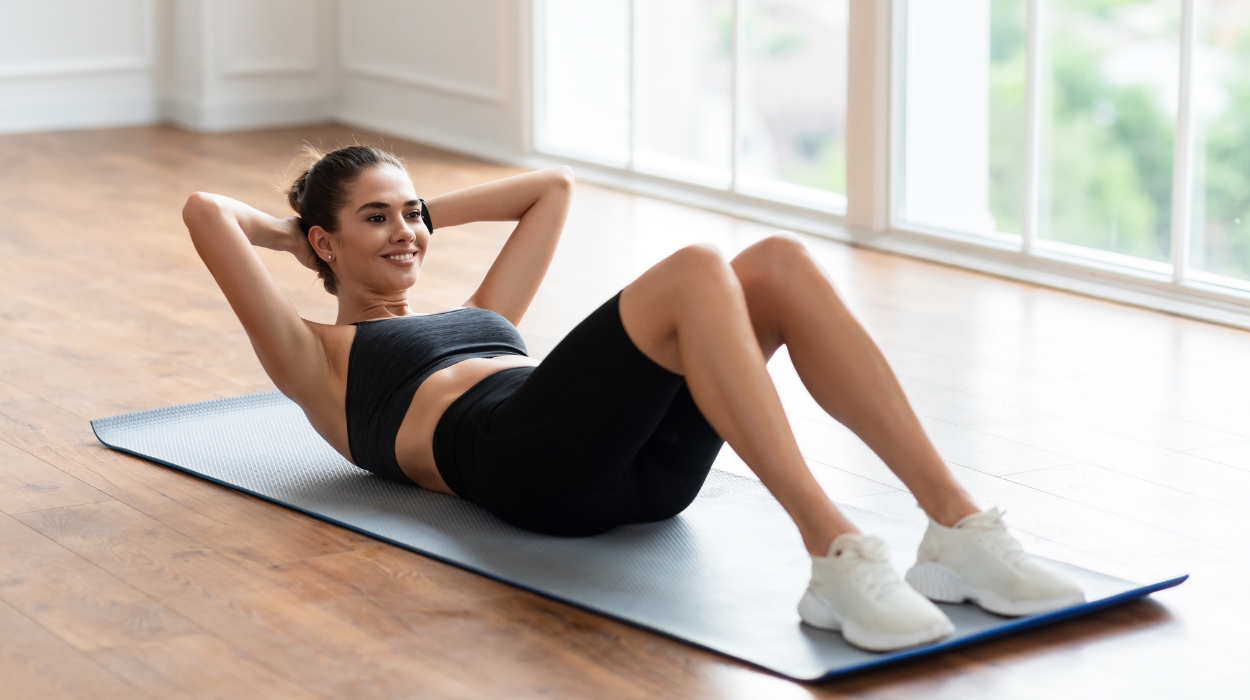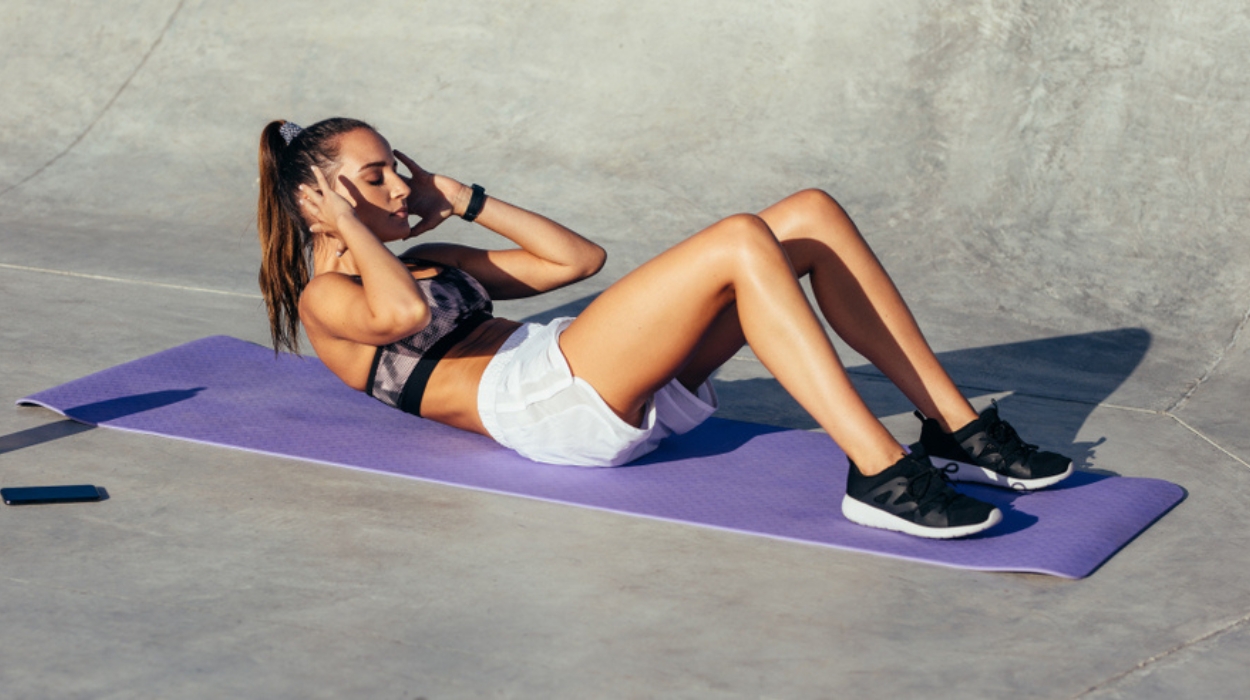Sit-ups are a popular core exercise that is simple to perform. In a traditional sit-up, you bend at the hips and lift your torso off the ground. Most people regard sit-ups as a common way to burn belly fat, but they may wonder if the evidence supports this popular claim.
Belly fat can be a source of immense frustration and can impact an individual’s body image and confidence. Losing or even just reducing belly fat is a common goal for those wanting to improve how they look and, importantly, how they feel.
Holding excessive fat, especially around the stomach area, can also be a risk factor for various adverse health issues. While you may assume sit-ups are a simple and effective way to reduce the stubborn fat stored around your torso, it may be more complex than that.
So, for those wanting to lose the extra weight around their midsection, a common question may arise: “Do sit-ups burn belly fat?”.
Do Sit-Ups Really Help Burn Belly Fat?
While sit-ups can help increase muscular strength and endurance in your core, performing sit ups alone won’t directly result in losing belly fat.
In order to successfully lose belly fat, overall body fat needs to be reduced.
Achieving and maintaining a calorie deficit is the primary factor for successful weight loss outcomes. Additionally, other lifestyle factors such as a healthy eating pattern and regular exercise can further help to effectively support a decrease in body fat and belly fat levels.
Do Sit-Ups Burn Belly Fat?
Sit-ups are commonly used in many fitness programs to target the core muscles. They are considered a resistance exercise that can help improve abdominal strength[1] and muscular endurance, but can crunches burn belly fat?
While performing isolated exercises specific to an area where you would like to lose body fat seems like a practical solution, it may require a little more time and consideration. Unfortunately, you cannot lose weight overnight, so reducing belly fat requires some dedication and consistency.
However, performing any exercise or physical activity will indeed burn energy in the form of calories, which can ultimately help you lose fat. Burning more calories than you consume is also referred to as a calorie deficit,[2] and this is essential for a successful weight loss outcome.
A calorie deficit can be created by either reducing your overall caloric intake, increasing your physical activity, or a combination of both.
Some diets recommend restricting carbohydrates or avoiding them altogether as a method of losing weight and ultimately, reducing body fat. Restricting carbohydrates can elicit weight loss results initially. The main reason for this is that the body stores carbohydrates and, with that, water.
Therefore, when you follow a low-carb diet, the body will use up its stores instead, which will lead to an initial reduction in weight. However, it is essential to highlight that such weight[3] loss is due to the loss of stored carbohydrates and water weight, not body fat. For this reason, it is not necessarily permanent weight loss.
Additionally, studies[4] have compared weight loss results from a healthy low-carb diet and a healthy low-fat diet. Both of these diets displayed similar results, which shows that a low-carb diet isn’t necessarily required to achieve weight loss. These studies also suggest that the specific distribution of macronutrients may not be as important as total energy intake and food quality for effective weight loss outcomes.
So, while performing sit-ups can indeed burn calories, which is an essential factor for burning fat, only performing sit-ups is unlikely to result in a significant loss of belly fat. In order to successfully lose body fat, it’s best to take a more comprehensive approach incorporating a wide range of different exercises, a healthy diet, and an overall healthier lifestyle.
Benefits Of Doing Sit-Ups
Sit-ups are one of the most commonly performed core exercises that target abdominal muscles to help build core strength. The traditional sit-up technique may vary slightly based on different sources. However, the main mechanisms of the exercise remain the same.
To perform a sit-up,[5] an individual will begin on their back with knees bent. They will either have their hands behind their head or straight alongside their body. The goal of the movement is to raise the trunk off the ground with a forward bend at the hips.
Sit-ups target the rectus abdominus,[6] which are the large muscles that people often refer to as the six-pack when visible.
The external oblique muscles are also effectively engaged when performing sit-ups. To maximize this exercise further, slow down when lowering your torso back to the ground to further activate[7] the abdominal muscles.
Slowing down and controlling the lowering phase of the movement, has proved to be a favorable method to increase muscular engagement effectively, and this simple adjustment can enhance abdominal muscle engagement, rather than feeling the need to perform a different exercise.
Performing sit-ups can help increase muscular strength and endurance in the core muscles. Sit-ups have also been proven to engage the hip flexors,[8] which makes them beneficial for more than one muscle group.
How Many Sit-Ups Should I Do To Burn Belly Fat?

There are no specific guidelines or amount of sit ups required to burn belly fat. As we have learned, doing sit-ups will not reduce belly fat directly because fat loss is dependent on maintaining a calorie deficit.
To successfully burn belly fat, you must first reduce your overall body fat. You can certainly incorporate sit-ups into your training program, but remember that in order to achieve your desired fat loss outcome, it’s best to utilize a comprehensive approach for best results.
To burn belly fat successfully, you should first determine your calorie intake and requirements to achieve a calorie deficit. Focusing on a healthy eating[9] pattern can also support your fat loss efforts; eating a diet rich in fruit, vegetables, whole grains, and lean proteins can support a healthy body weight while positively contributing to your overall health.
Another key consideration that can have a significant influence is exercise.
Aerobic[10] exercise has consistently proven a successful way to lose weight. Performing at least 150 minutes[11] of moderate aerobic exercise or at least 75 minutes of vigorous-intensity exercise each week is recommended to maintain good health and can further support successful weight loss outcomes.
Incorporating resistance training in addition to aerobic exercise can contribute to the maintenance and development of lean muscle mass. This can contribute to weight loss while helping promote fat loss.
Furthermore, understanding the role of muscle mass in energy expenditure sheds light on how resistance training can have a greater effect on weight management beyond performing only aerobic exercise alone.
Muscle requires more energy to maintain than fat does; having a higher muscle mass will result in a higher metabolic rate, which will help you burn more calories even when at rest. This can further contribute to maintaining a calorie deficit, promoting effective fat loss.
The Truth About Sit-Ups

While sit-ups may be effective in directly engaging the abdominal muscles, there may be some other downsides to this popular exercise choice.
Firstly, the traditional sit-up also engages the hip flexors[12] during the movement, meaning that if the intention is to target only the abdominal muscles, you may be better served performing other exercises.
Secondly, the motion of a sit-up places excessive strain on the lower back and spine. This strain may increase your risk of injury[7] if you already have problems in the lower back.
We established that sit-ups can engage the muscles in your core and slow and controlled torso lowering can increase the activation of muscles in this area. However, there may be other abdominal exercises that are more effective in strengthening these muscles.
Incorporating a combination of alternative exercises that target different areas of the core in various movement capacities can contribute to a more comprehensive and well-rounded exercise routine.
Exercises such as planks and hollow holds contribute to core stability. Cable rotations engage your obliques, ab-wheel rollouts develop anti-extension capacity and back extensions work the supporting posterior muscles.
This combination will not only help develop overall core strength but also reduce the likelihood of muscular imbalances, promoting a robust core.
Conclusion
Sit-ups are a popular core exercise that many individuals may look to utilize in the hopes of reducing their belly fat and achieving a toned midsection.
While sit-ups can be considered a resistance exercise that are frequently utilized to increase abdominal strength and endurance, simply performing this exercise alone is unlikely to lead to a significant reduction in belly fat.
To lose excess fat, a reduction in total weight loss needs to be achieved. Achieving and maintaining an appropriate calorie deficit is the underlying mechanism for successful weight loss. In conjunction with maintaining a calorie deficit, other factors can further contribute to weight loss outcomes.
Following a healthy eating pattern rich in fruits, vegetables, whole grains, and lean proteins along with incorporating strength training and aerobic exercise are additional factors that can help you lose weight, develop muscle mass, and increase your metabolism.
Therefore, while sit-ups can offer some benefits in relation to core strengthening, performing sit-ups will not burn belly fat directly. You should take a combination of lifestyle factors into consideration to maximize your weight loss results and reduce abdominal fat.
Frequently Asked Questions
Sit-ups won’t directly get rid of belly fat. But, including sit-ups in your training program, in conjunction with cardio and a healthy diet, can lead to weight loss and a decrease in body fat, including belly fat.
There is no set number recommended each day. Instead of completing an excessive number of sit-ups daily which could result in muscle fatigue, it’s more effective to focus on a combination of diet, exercise, and sleep.
There is no best exercise to lose belly fat. Losing belly fat successfully is dependent on reducing your overall body fat. Regularly performing a combination of aerobic exercise and strength training has shown to be most effective for fat loss.
Effective weight loss takes time. Therefore, doing 100 sit-ups once will only exhaust your muscles in the short term. It could be better to follow a well-balanced program with other core strengthening exercises to effectively develop total core strength instead.
 Evidence Based
Evidence Based
